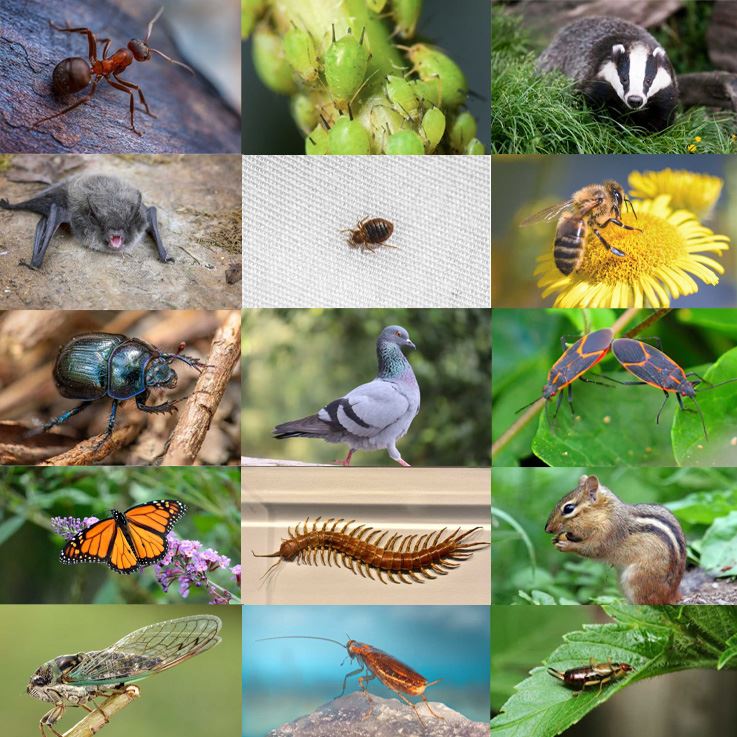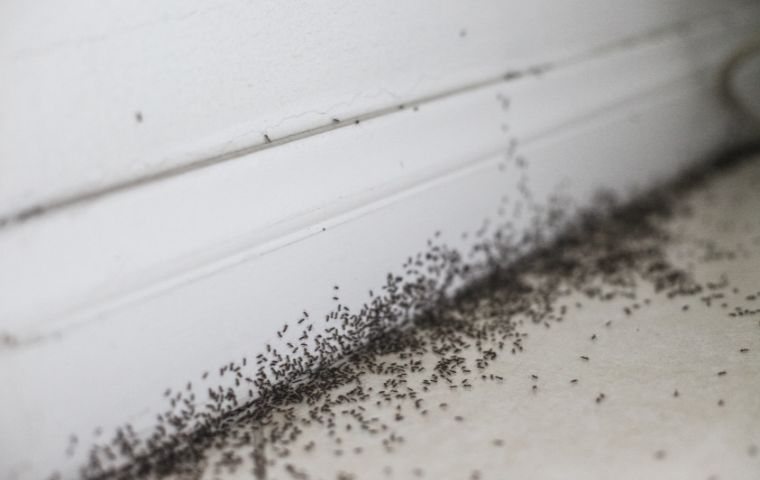
What Are Ants?
Ants are small social insects belonging to the family Formicidae, and they are among the most diverse and numerous insects on the planet. Here's an overview of ants:
Are Ants Harmful?
Ants can be considered harmful in several ways, depending on the species and the environment they invade. Here are the primary concerns:
- Bites and Stings: Some ants, such as fire ants, deliver painful stings that cause burning, itching, and allergic reactions. Severe cases can lead to anaphylaxis in sensitive individuals.
- Disease Transmission: While ants are not direct disease carriers like mosquitoes, they can crawl over contaminated surfaces and food, potentially spreading bacteria like Salmonella and E. coli.
- Infestation in Kitchens and Pantries: Ants are attracted to sugary and greasy foods, contaminating them by walking over them.
- Difficult to Control: Some ants, like pharaoh ants, scatter their colonies when disturbed, making eradication efforts challenging.
- Carpenter Ants: Carpenter ants burrow into wood to create nests, which can weaken the structural integrity of buildings, much like termites.
- Fire Ants: Fire Ants can build large mounds in yards, damaging landscaping and potentially affecting the foundation of structures.
- Short Circuits and Equipment Failure: Species like tawny crazy ants and fire ants are known to nest in electrical boxes, causing short circuits, power outages, and damage to wiring and appliances.
Learn more: What Do Ant Bites Look Like?
Ant Types
- Acrobat Ants: Acrobat ants are known for their heart-shaped abdomen and an ability to raise their abdomen over their head when disturbed. They often nest in rotting wood.
- Argentine Ants: Argentine ants are small, light to dark brown ants that form large super colonies. They are highly invasive and known for displacing native ant species.
- Bigheaded Ants: Named for their large heads, bigheaded ants come in various colors and are usually found in tropical regions.
- Carpenter Ants: Carpenter ants are larger ants that are often black or reddish-brown, known for tunneling into wood to build their nests. They do not eat wood but can cause structural damage to buildings.
- Citronella Ants: Citronella ants are yellow to light brown ants that emit a lemony or citronella-like odor when crushed, and typically nest underground.
- Field Ants: Field ants are generally larger ants with colors ranging from black to red, that nest in the ground.
- Fire Ants: Fire ants are small, reddish-brown ants with a painful sting. They build large, mound-like nests and are considered invasive pests.
- Little Black Ants: Little black ants are small, shiny black ants that are often found invading homes in search of food.
- Odorous House Ants: Odorous house ants, also known as sugar ants, are small brown or black ants that emit a foul odor when crushed, similar to rotten coconut.
- Pavement Ants: Pavement ants are small brown or black ants that nest under sidewalks and pavements, hence their name.
- Pharaoh Ants: Pharaoh ants are tiny yellow or light brown ants that are notorious indoor pests. They are challenging to control due to their colony structure.
- Thief Ants: Thief ants are very small, pale ants that get their name from their habit of stealing food from the nests of other ants.
- Velvet Ants: Velvet ants are actually wingless wasps, not ants. They have striking red and black coloration and are known for their potent stinger.
Ant Appearance
Ants are small, social insects belonging to the family Formicidae. They exhibit a wide range of characteristics in terms of appearance, depending on their species and roles within the colony. However, there are some common features that can help you identify ants:
- Size: Ants vary in size, but most species are relatively small, typically ranging from 1 to 5 millimeters in length. Some larger species can grow up to 1 inch.
- Body Segmentation: An ant's body is divided into three distinct segments: head, thorax, and abdomen. The head is equipped with antennae, mandibles (jaws), and compound eyes.
- Color: Ants come in various colors, including black, brown, red, yellow, and even some metallic hues. The color may differ depending on the species.
- Antennae: Antennae are important sensory organs for ants. They are usually elbowed and composed of multiple segments. The shape and size of antennae can vary between species.
- Mandibles: Ants have powerful mandibles that they use for various tasks, such as carrying food and excavating tunnels.
- Waist: Ants have a constricted waist between the thorax and abdomen, which is often a distinguishing feature. This waist can be single or double, depending on the species.
- Legs: Ants have six legs, which are generally relatively long and well-suited for walking and climbing.
- Wings: Some ants have wings, especially during specific stages of their life cycle. Winged ants are often referred to as "alates" and are usually seen during mating flights. After mating, they may shed their wings.
- Hairs and Sculpture: Ants may have fine hairs and distinct body sculpturing, which can be used for species identification under a microscope.
- Role-Specific Characteristics: The appearance of ants can vary within a colony based on their roles. Worker ants are typically smaller and have specialized features for their tasks, while queens and males may have different characteristics, especially during the mating phase.
There are over 12,000 known ant species, so there can be significant variation in appearance among them. If you're trying to identify a specific ant species, it may require a more detailed examination or the expertise of an entomologist.
Learn more: Do Ants Fly?
Learn more: Ants vs Termites
Ant Habitat
Ants are highly adaptable insects, and you can encounter them in a wide range of environments, both indoors and outdoors. Here are some common places where you might come across ants:
- Outdoors: Ants are frequently found in gardens, lawns, and other outdoor spaces, where they forage for food and build nests in the soil. Ants are essential components of many ecosystems, and you can find them in forests, grasslands, and other natural environments.
- Around Buildings: Ants can enter homes in search of food or water. Common indoor species include the odorous house ant, pavement ant, and carpenter ant. Ants are often attracted to kitchens because of the availability of food scraps and water. They may come in through cracks or gaps. Ants might be found in bathrooms, especially if they're seeking water sources. Some ants, like pharaoh ants, can nest in wall voids and under flooring.
- Picnic Areas and Campgrounds: Ants are drawn to places where people eat or leave food scraps, making picnic areas and campgrounds common locations to encounter them.
- Pet Food Bowls: Ants are attracted to pet food, so they may gather around your pet's food bowl.
- Playgrounds: Children's play areas can sometimes be infested with ants, particularly if there are food remnants.
- Hiking Trails: While hiking, you may encounter ants on the ground, especially if you disturb their nests.
- Farms and Agricultural Areas: Ants can be found in agricultural fields, where they play various roles in ecosystems.
- Trash Bins and Compost Piles: Ants are often attracted to trash bins and compost piles, where they can find food and organic matter.
- Tree Trunks and Foliage: Some ant species make nests in tree trunks or build nests in foliage.
- Construction Sites: Carpenter ants, in particular, are known for nesting in wood, and they may be found at construction sites.
Ants are ecologically significant and play various roles in different environments. While some species can be pests in homes and gardens, others are beneficial as they contribute to soil aeration and nutrient cycling. If you have issues with ants in your home, it's advisable to address the source of the problem, such as eliminating food sources and sealing entry points, or consult an ant control professional for assistance.
Learn more: How To Get Rid Of Tiny Ants In Your Kitchen
Learn more: Natural Ant Repellents
Learn more: Baking Soda And Sugar For Ants
Ant Diet
Ants are omnivorous insects with a varied diet, and their food preferences can vary depending on the species and the needs of their colony. Here's an overview of what ants eat:
- Sugary Substances: Many ant species have a sweet tooth and are attracted to sugary substances. This includes nectar from flowers, honeydew produced by aphids and other insects, and sugary food scraps in human environments.
- Protein Sources: Ants need protein for growth and development. They obtain protein from various sources. For example, ants are known to hunt and capture other insects, such as flies, caterpillars, and small arthropods. Some species scavenge on dead insects, small vertebrates, or even bird carcasses. In human environments, ants may feed on meat, pet food, or dairy products.
- Fats and Oils: Certain ant species are attracted to fatty or oily substances. They may forage for oils, greases, and fatty food scraps.
- Plant Matter: While ants primarily require sugar and protein, they also consume plant matter, including leaves, seeds, and fruits.
- Fungus Farming: Leafcutter ants and some other species engage in farming. They cultivate fungus gardens by cutting and chewing leaves, which serve as a substrate for their fungal food source.
- Honeydew: Ants form mutualistic relationships with aphids, scale insects, and mealybugs. These insects produce honeydew, a sweet, sticky substance that ants "milk" and consume.
- Dead Insects: Some ant species are opportunistic scavengers and will feed on the corpses of insects or other small animals they come across.
- Extrafloral Nectaries: Certain plants have extrafloral nectaries that produce nectar outside of their flowers. Ants may be attracted to these nectaries as a food source.
- Hunting and Gathering Behavior: Ants often exhibit complex foraging behavior, with different castes specializing in specific food types. Some ants may act as foragers, while others handle storage or food processing duties.
- Storage Organs: Some ants are known to dig up and consume underground storage organs of plants, like tubers and bulbs.
- Food Storage: Ants store food within their nests in the form of trophallaxis, a process where they exchange liquid food with nestmates. This helps distribute food resources evenly within the colony.
Ants are incredibly resourceful and adapt their diets to what is readily available in their environment. The specific food preferences of ants can vary greatly between species, and even within a single colony, different castes may have different dietary requirements based on their roles in the colony.
Learn more: What Do Ants Eat?

Ant Life Cycle
Ants go through a complete metamorphosis with four distinct stages in their life cycle: egg, larva, pupa, and adult. The duration of each stage varies depending on the species, environmental conditions, and caste (worker, queen, or male). Below is a breakdown of each stage:
- Egg Stage: The life cycle begins when the queen lays eggs. Ant eggs are tiny, oval, and translucent white. If fertilized, they develop into female ants (workers or queens); if unfertilized, they become male ants. Eggs typically hatch within 1-2 weeks, depending on the species and environmental factors like temperature and humidity.
- Larva Stage: Once hatched, the ant larvae resemble small, legless worms. They rely on worker ants for food, which is regurgitated into their mouths (trophallaxis). During this stage, they grow rapidly and molt several times as they shed their outer skin. Their diet, especially for potential queens, may be richer in proteins and fats to support their development.
- Pupa Stage: After reaching full size, the larva transforms into a pupa. In some species, pupae are enclosed in a silk cocoon, while others remain exposed. The pupa undergoes internal changes, developing adult body structures such as legs, antennae, and wings (for reproductive ants). This stage lasts anywhere from a few days to several weeks, depending on conditions and species.
- Adult Stage: Once fully developed, the ant emerges as an adult. Adult ants belong to one of three castes. Queens are larger, fertile females responsible for reproduction. They can live for several years. Workers are sterile females that handle foraging, nest maintenance, and caring for the young. They live for several weeks to a few years. The sole purpose of Males (Drones) is to mate with a queen. They have wings and die shortly after mating.
- Ant colonies grow as queens continue to lay eggs, and workers expand the nest and care for offspring.
- Once a colony matures, it produces new reproductive ants (winged males and females) that participate in a nuptial flight, starting new colonies after mating.
Understanding the ant life cycle is crucial for effective ant control, as targeting specific stages can help disrupt colony growth.
Learn more about: Ant Colonies
Learn more: What Do Ant Eggs Look Like?
Learn more: What Are Ant Larvae?
Learn more: What Do Queen Ants Look Like?

Hear From Our Happy Customers
-
"Fantastic & Patient"
Jarvis was fantastic and patient. He answered my questions with an in-depth explanation and addressed all of my areas of concern. Would love for him to be my assigned tech going forward. Well done!
- Yonnette M. -
"Professional & Considerate"
I’m pleased with Miche services. Jarvis came today. Professional and considerate. Thank you!
- Judy B. -
"Wonderful Service"
Wonderful service. Jarvis is great. Took care of everything I needed. Thank you!
- Henry P. -
"Great Communication"
Tech was on time, communication was great, and he accommodated my needs.
- Alonzo W. -
"Exceeds Expectations"
I can’t say enough positive things about this company... The tech that came out, Jarvis went above and beyond my expectations. Thank you guys, I will continue using your services.
- Jake M. -
"Very Knowledgeable"
The tech that arrived was courteous, professional, and very knowledgeable. He was Great.
- Uerial I.




